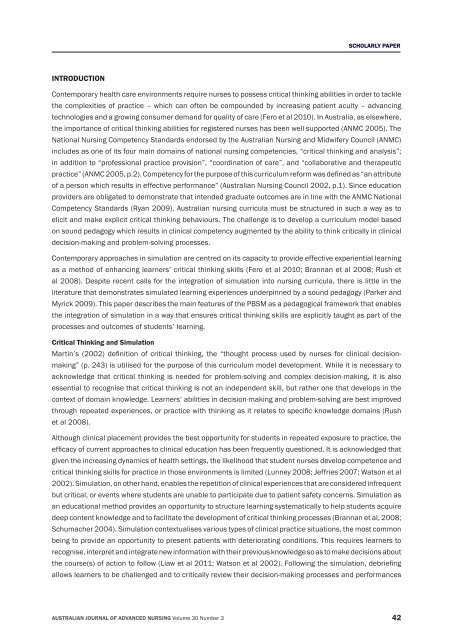Download Complete Issue - Australian Journal of Advanced Nursing
Download Complete Issue - Australian Journal of Advanced Nursing
Download Complete Issue - Australian Journal of Advanced Nursing
Create successful ePaper yourself
Turn your PDF publications into a flip-book with our unique Google optimized e-Paper software.
SCHOLARLY PAPERINTRODUCTIONContemporary health care environments require nurses to possess critical thinking abilities in order to tacklethe complexities <strong>of</strong> practice – which can <strong>of</strong>ten be compounded by increasing patient acuity – advancingtechnologies and a growing consumer demand for quality <strong>of</strong> care (Fero et al 2010). In Australia, as elsewhere,the importance <strong>of</strong> critical thinking abilities for registered nurses has been well supported (ANMC 2005). TheNational <strong>Nursing</strong> Competency Standards endorsed by the <strong>Australian</strong> <strong>Nursing</strong> and Midwifery Council (ANMC)includes as one <strong>of</strong> its four main domains <strong>of</strong> national nursing competencies, “critical thinking and analysis”;in addition to “pr<strong>of</strong>essional practice provision”, “coordination <strong>of</strong> care”, and “collaborative and therapeuticpractice” (ANMC 2005, p.2). Competency for the purpose <strong>of</strong> this curriculum reform was defined as “an attribute<strong>of</strong> a person which results in effective performance” (<strong>Australian</strong> <strong>Nursing</strong> Council 2002, p.1). Since educationproviders are obligated to demonstrate that intended graduate outcomes are in line with the ANMC NationalCompetency Standards (Ryan 2009), <strong>Australian</strong> nursing curricula must be structured in such a way as toelicit and make explicit critical thinking behaviours. The challenge is to develop a curriculum model basedon sound pedagogy which results in clinical competency augmented by the ability to think critically in clinicaldecision-making and problem-solving processes.Contemporary approaches in simulation are centred on its capacity to provide effective experiential learningas a method <strong>of</strong> enhancing learners’ critical thinking skills (Fero et al 2010; Brannan et al 2008; Rush etal 2008). Despite recent calls for the integration <strong>of</strong> simulation into nursing curricula, there is little in theliterature that demonstrates simulated learning experiences underpinned by a sound pedagogy (Parker andMyrick 2009). This paper describes the main features <strong>of</strong> the PBSM as a pedagogical framework that enablesthe integration <strong>of</strong> simulation in a way that ensures critical thinking skills are explicitly taught as part <strong>of</strong> theprocesses and outcomes <strong>of</strong> students’ learning.Critical Thinking and SimulationMartin’s (2002) definition <strong>of</strong> critical thinking, the “thought process used by nurses for clinical decisionmaking”(p. 243) is utilised for the purpose <strong>of</strong> this curriculum model development. While it is necessary toacknowledge that critical thinking is needed for problem-solving and complex decision-making, it is alsoessential to recognise that critical thinking is not an independent skill, but rather one that develops in thecontext <strong>of</strong> domain knowledge. Learners’ abilities in decision-making and problem-solving are best improvedthrough repeated experiences, or practice with thinking as it relates to specific knowledge domains (Rushet al 2008).Although clinical placement provides the best opportunity for students in repeated exposure to practice, theefficacy <strong>of</strong> current approaches to clinical education has been frequently questioned. It is acknowledged thatgiven the increasing dynamics <strong>of</strong> health settings, the likelihood that student nurses develop competence andcritical thinking skills for practice in those environments is limited (Lunney 2008; Jeffries 2007; Watson et al2002). Simulation, on other hand, enables the repetition <strong>of</strong> clinical experiences that are considered infrequentbut critical, or events where students are unable to participate due to patient safety concerns. Simulation asan educational method provides an opportunity to structure learning systematically to help students acquiredeep content knowledge and to facilitate the development <strong>of</strong> critical thinking processes (Brannan et al, 2008;Schumacher 2004). Simulation contextualises various types <strong>of</strong> clinical practice situations, the most commonbeing to provide an opportunity to present patients with deteriorating conditions. This requires learners torecognise, interpret and integrate new information with their previous knowledge so as to make decisions aboutthe course(s) <strong>of</strong> action to follow (Liaw et al 2011; Watson et al 2002). Following the simulation, debriefingallows learners to be challenged and to critically review their decision-making processes and performancesAUSTRALIAN JOURNAL OF ADVANCED NURSING Volume 30 Number 3 42
















